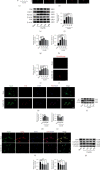Activation of SIRT1 Alleviates Ferroptosis in the Early Brain Injury after Subarachnoid Hemorrhage
- PMID: 35855863
- PMCID: PMC9288286
- DOI: 10.1155/2022/9069825
Activation of SIRT1 Alleviates Ferroptosis in the Early Brain Injury after Subarachnoid Hemorrhage
Abstract
Ferroptosis is a regulated cell death that characterizes the lethal lipid peroxidation and iron overload, which may contribute to early brain injury (EBI) pathogenesis after subarachnoid hemorrhage (SAH). Although Sirtuin 1 (SIRT1), a class III histone deacetylase, has been proved to have endogenous neuroprotective effects on the EBI following SAH, the role of SIRT1 in ferroptosis has not been studied. Hence, we designed the current study to determine the role of ferroptosis in the EBI and explore the correlation between SIRT1 and ferroptosis after SAH. The pathways of ferroptosis were examined after experimental SAH in vivo (prechiasmatic cistern injection mouse model) and in HT-22 cells stimulated by oxyhemoglobin (oxyHb) in vitro. Then, ferrostatin-1 (Fer-1) was used further to determine the role of ferroptosis in EBI. Finally, we explored the correlation between SIRT1 and ferroptosis via regulating the expression of SIRT1 by resveratrol (RSV) and selisistat (SEL). Our results showed that ferroptosis was involved in the pathogenesis of EBI after SAH through multiple pathways, including acyl-CoA synthetase long-chain family member 4 (ACSL4) activation, iron metabolism disturbance, and the downregulation of glutathione peroxidase 4 (GPX4) and ferroptosis suppressor protein 1 (FSP1). Inhibition of ferroptosis by Fer-1 significantly alleviated oxidative stress-mediated brain injury. SIRT1 activation could suppress SAH-induced ferroptosis by upregulating the expression of GPX4 and FSP1. Therefore, ferroptosis could be a potential therapeutic target for SAH, and SIRT1 activation is a promising method to inhibit ferroptosis.
Copyright © 2022 Bin Yuan et al.
Conflict of interest statement
The authors declared that there is no conflict of interest regarding the publication of this paper.
Figures






Similar articles
-
Acyl-CoA synthetase long chain family member 4 plays detrimental role in early brain injury after subarachnoid hemorrhage in rats by inducing ferroptosis.CNS Neurosci Ther. 2021 Apr;27(4):449-463. doi: 10.1111/cns.13548. Epub 2020 Dec 12. CNS Neurosci Ther. 2021. PMID: 33314758 Free PMC article.
-
Inhibition of Ferroptosis Alleviates Early Brain Injury After Subarachnoid Hemorrhage In Vitro and In Vivo via Reduction of Lipid Peroxidation.Cell Mol Neurobiol. 2021 Mar;41(2):263-278. doi: 10.1007/s10571-020-00850-1. Epub 2020 Apr 20. Cell Mol Neurobiol. 2021. PMID: 32314126 Free PMC article.
-
Resveratrol alleviates early brain injury following subarachnoid hemorrhage: possible involvement of the AMPK/SIRT1/autophagy signaling pathway.Biol Chem. 2018 Oct 25;399(11):1339-1350. doi: 10.1515/hsz-2018-0269. Biol Chem. 2018. PMID: 30067508
-
The mechanism of ferroptosis in early brain injury after subarachnoid hemorrhage.Front Immunol. 2023 May 17;14:1191826. doi: 10.3389/fimmu.2023.1191826. eCollection 2023. Front Immunol. 2023. PMID: 37266433 Free PMC article. Review.
-
Iron Metabolism and Ferroptosis in Early Brain Injury after Subarachnoid Haemorrhage.Mol Neurobiol. 2024 Dec;61(12):10736-10746. doi: 10.1007/s12035-024-04218-0. Epub 2024 May 23. Mol Neurobiol. 2024. PMID: 38777982 Free PMC article. Review.
Cited by
-
Ferroptosis in early brain injury after subarachnoid hemorrhage: review of literature.Chin Neurosurg J. 2024 Feb 13;10(1):6. doi: 10.1186/s41016-024-00357-4. Chin Neurosurg J. 2024. PMID: 38347652 Free PMC article. Review.
-
Transfer of cGAMP from neuron to microglia activates microglial type I interferon responses after subarachnoid hemorrhage.Cell Commun Signal. 2024 Jan 2;22(1):3. doi: 10.1186/s12964-023-01362-3. Cell Commun Signal. 2024. PMID: 38169382 Free PMC article.
-
Perampanel attenuates oxidative stress and pyroptosis following subarachnoid hemorrhage via the SIRT3/FOXO3α pathway.Sci Rep. 2023 Dec 3;13(1):21320. doi: 10.1038/s41598-023-48802-1. Sci Rep. 2023. PMID: 38044382 Free PMC article.
-
Therapeutic potential of resveratrol through ferroptosis modulation: insights and future directions in disease therapeutics.Front Pharmacol. 2024 Sep 25;15:1473939. doi: 10.3389/fphar.2024.1473939. eCollection 2024. Front Pharmacol. 2024. PMID: 39386035 Free PMC article. Review.
-
Elucidating the progress and impact of ferroptosis in hemorrhagic stroke.Front Cell Neurosci. 2023 Jan 11;16:1067570. doi: 10.3389/fncel.2022.1067570. eCollection 2022. Front Cell Neurosci. 2023. PMID: 36713782 Free PMC article. Review.
References
-
- Rahman M. M., Islam F., Parvez A., et al. Citrus limon L. (lemon) seed extract shows neuro-modulatory activity in an in vivo thiopental-sodium sleep model by reducing the sleep onset and enhancing the sleep duration. Journal of Integrative Neuroscience . 2022;21(1):p. 42. doi: 10.31083/j.jin2101042. - DOI - PubMed
MeSH terms
Substances
LinkOut - more resources
Full Text Sources
Research Materials

